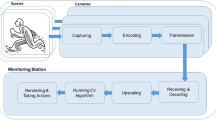Abstract
Surveillance systems include a large set of techniques for both low level and high level tasks. In particular, in the last decade the research community has witnessed a high proliferation of techniques that span from object detection and tracking to object recognition and event understanding. Although some techniques have been proved to be very effective, those tasks cannot be considered solved. Even less, we can consider concluded the research in the field of the analysis of the activities (event analysis). It is this topic together with the problem of the information sharing among different sensors that represents the core of this work. Here, a system architecture for a video surveillance system with distributed intelligence over multiple processing units and with distributed communication over multiple heterogeneous channels (wireless, satellite, local IP networks, etc.) is proposed. A new real-time technique for changing the video transmission parameters (e.g., frame rate, spatial/colour resolution, etc.) according to the available bandwidth (which depends on the number of the detected alarm situations, on the required video quality, etc.) will be presented.
Similar content being viewed by others
References
Bhandarkar, S., Luo, X.: Fast and robust background updating for real-time traffic surveillance and monitoring. In: IEEE International Conference on Computer Vision and Pattern Recognition, vol. 3, pp. 55–59. San Diego (2005)
Bjontegaard G., Lillevold K. and Danielsen R. (1996). A comparison of different coding formats for digital coding of video using mpeg-2. IEEE Trans Image Process 5(8): 1271–1276
Collins R., Lipton A., Fujiyoshi H. and Kanade T. (2001). Algorithms for cooperative multisensor surveillance. Proc IEEE 89: 1456–1477
Collins, R., Lipton, A., Kanade, T., Fujiyoshi, H., Tsin, D.D.Y., Tolliver, D., Enomoto, N., Hasegawa, O.: A system for video surveillance and monitoring. Technical Report CMU-RI-TR-00-12, Robotics Institute, Carnegie Mellon University, Pittsburgh (2000)
Fan J., Yau D., Elmagarmid A. and Aref W. (2001). Automatic image segmentation by integrating color-edge extractionand seeded region growing. IEEE Trans Image Process 10(10): 1454–1466
Foresti G. and Dolso T. (2004). Adaptive high-order neural trees for pattern recognitionadaptive high-order neural trees for pattern recognition. IEEE Trans Syst Man Cybern Part B 34(2): 988–996
Foresti G., Micheloni C., Snidaro L., Remagnino P. and Ellis T. (2005). Advanced image and video processing in active video-based surveillancesystems. IEEE Signal Process Mag 22(2): 25–37
Foresti G., Regazzoni C. and Visvanathan R. (2001). Scanning the issue technology—special issue on video communications,processing and understanding for third generation surveillance systems. Proc IEEE 89(10): 1355–1367
Haritaoglu S., Harwood D. and Davis L. (2000). W 4: Real-time surveillance of people and their activities. IEEE Trans Pattern Anal Mach Intell 22(8): 809–830
Hata, T., Kuwahara, N., Nozawa, T., Schwenke, D., Vetro,~A.: Surveillance system with object-aware video transcoder. In: International Workshop on Multimedia Signal Processing. Shangai, China (2005)
ISO/IEC: Coding of moving pictures and associated audio for digital storage media at up to about 1,5 Mbit/s – Part 2, 11172-2 edn (1993)
ISO/IEC JTC1: Coding f audio-Visual Objects -Part2: Visual, iso/iec 14 496-2 edn (1999))
ITU-T: Video Codec for Audiovisual Services at px 64 Kbit/s Version 1, itu-t reccomendation h.261 edn (1990)
Ivanov Y.A. and Bobick A.F. (2000). Recognition of visual activities and interactions by stochastic parsing. IEEE Trans Pattern Anal Mach Intell 22(8): 852–872
Kapur J.N., Sahoo P.K. and Wong A.K.C. (1985). A new method for gray-level picture thresholding using the entropy of the histogram. Graph Models Image Process 29: 273–285
Liao S. and Pawlak M. (1996). On image analysis by moments. IEEE Trans Pattern Anal Mach Intelli 18: 254–266
Makris D. and Ellis T. (2005). Learning semantic scene models from observing activity in visual surveillance. IEEE Trans Syst Man Cybern Part B: Cybern 35(3): 397–408
Micheloni C., Foresti G. and Snidaro L. (2005). A network of cooperative cameras for visual-surveillance. IEE Visual, Image Signal Process 152(2): 205–212
Otsu N. (1979). A threshold selection method from gray level histograms. IEEE Trans Syst Man Cybern SMC- 9: 62–66
Petersen, J.: Understanding Surveillance Tehnologies. CRC, Boca Raton (2001)
Piciarelli, C., Foresti, G.: Event recognition by dynamic trajectory analysis and prediction. In: IEE Image for Crime Detection and Prevention. Savoy Place, London (2005)
Ridler T.W. and Calvard S. (1978). Picture thresholding using an iterative selection method. IEEE Trans Syst Man Cybern SMC- 8: 630–632
Rosin, P.: Thresholding for change detection. In: Proceedings of IEEE International Conference on Computer Vision, pp.~274–279. Bombay, India (1998)
Snidaro L. and Foresti G. (2003). Real-time thresholding with Euler numbers. Pattern Recogn Lett 24(9–10): 1533–1544
Stauffer C. and Grimson W.E.L. (2000). Learning patterns of activity using real-time tracking. IEEE Pattern Anal Mach Intell 22(8): 747–757
Thimm G. and Fiesler E. (1997). High-order and multilayer perceptron initialization. IEEE Trans Neural Netw 8(2): 349–359
Wiegand T., Scwarz H., Joch A., Kossentini F. and Sullivan G. (2003). Rate-constrained coder control and comparison of video coding standard. IEEE Trans Circuits Syst Video Technol 13(7): 7
Zitova B. and Flusser J. (2003). Image registration methods: a survey. Image Vis Comput 21: 977–1000
Tao Z. and Nevatia R. (2004). Tracking multiple humans in complex situations. IEEE Trans Pattern Anal Mach Intell 26(9): 1208–1221
Author information
Authors and Affiliations
Corresponding author
Rights and permissions
About this article
Cite this article
Micheloni, C., Lestuzzi, M. & Foresti, G.L. Adaptive video communication for an intelligent distributed system: Tuning sensors parameters for surveillance purposes. Machine Vision and Applications 19, 359–373 (2008). https://doi.org/10.1007/s00138-007-0069-z
Received:
Accepted:
Published:
Issue Date:
DOI: https://doi.org/10.1007/s00138-007-0069-z




